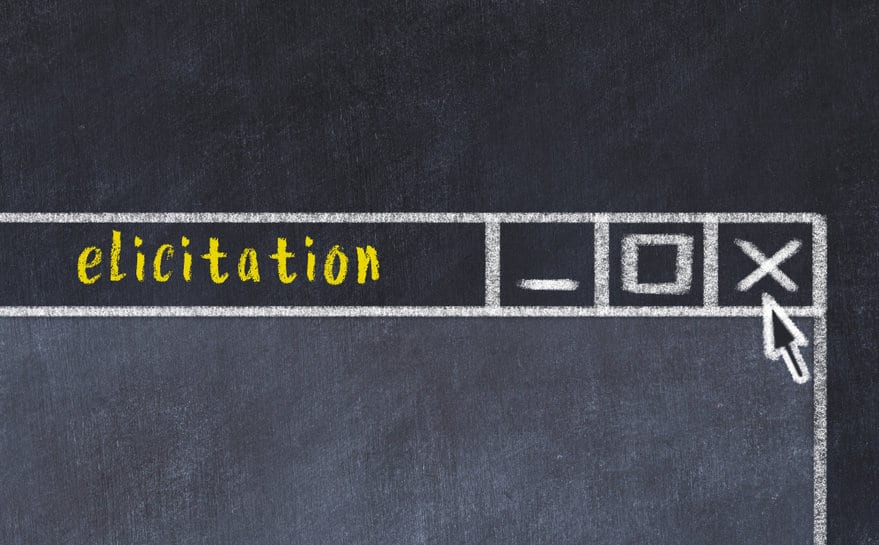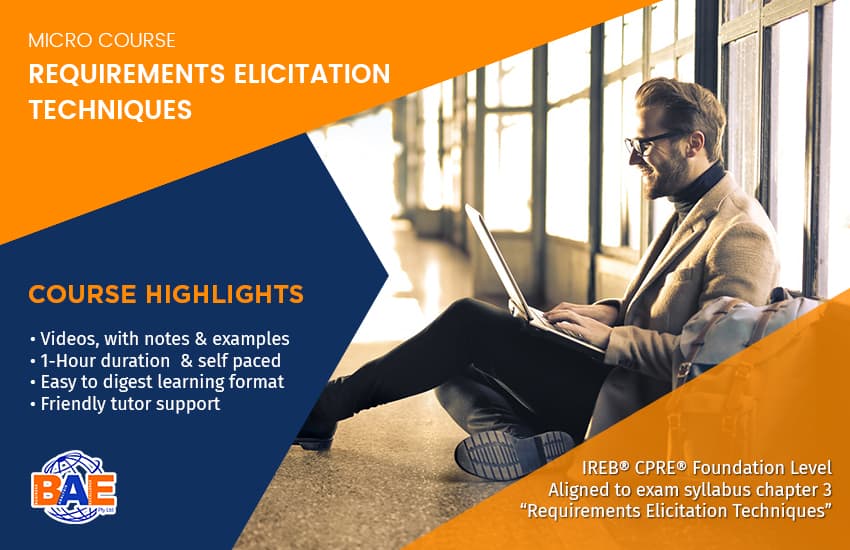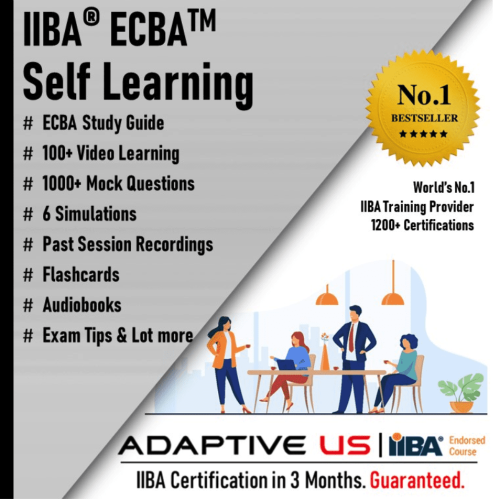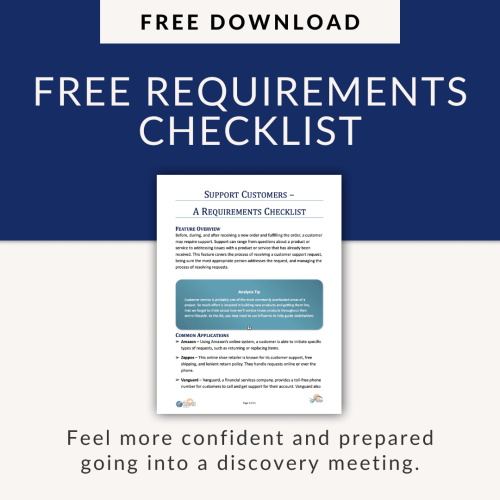Table of Contents
Elicitation is Critical to Your Business Analysis Work
Elicitation is one the most challenging aspects to learn for a business analyst, yet it also provides an opportunity to develop a collection of skills that a business analysts can use on a variety of projects throughout their business analysis career path
As a business analyst
What is Elicitation?
Elicitation is the process of working with stakeholders to understand what they want to achieve through the project or to understand how the business is organised today. A stakeholder is someone who owns or provides input on a specific aspect of the project or the organisation. Stakeholders might have a very clear picture of what they want and what they do, or they might be vague and ambiguous.
Elicitation involves bringing out the best ideas from people who see all the different aspects of the problem and includes documenting the results of what you find. So, if you sit down and observe someone do their work and then you create a work-flow document that represents the understanding you achieved through that observation, you just completed some elicitation.
Active Listening – Your Most Important Elicitation Skills
While it may seem counter-intuitive, one of the most important verbal communication skills that you can develop is your ability to actively listen. Listening involves the act of “hearing” at its most basic level but is about understanding – understanding truly what the person talking to you is trying to communicate.
It also involves asking relevant follow-up questions until you develop a shared understanding with that person about what they are trying to tell you.
Asking Good Questions
Another key ability of a business analyst when it comes to one-on-one discussions is the ability to ask good questions, questions that provoke real conversation and where necessary, maybe even a bit of debate.
Think about the questions that you ask.
- Do you ask, typically, yes or no questions where somebody can just say “yes” or “no”?
- Or do you ask open-ended questions?
Open-ended questions allow for multiple responses and some of the best questions are the ones that get an answer that had nothing to do with what I thought I was looking for.
The 9 Elicitation Techniques
In its simplest form, elicitation is the process of discovering requirements or business needs. It is important to use a very rigorous process to do elicitation because so often stakeholders do not have a direct view of the problem. There are several elicitation techniques.
Requirements Workshops
A requirements workshops is also a useful requirement elicitation techniques. This is a structured meeting attended by multiple stakeholders. Typically, it’s facilitated either by the business analyst or possibly a professional facilitator. The business analyst may work with a group of stakeholders to develop a model or develop a prototype. At the end of that workshop, the business analyst may have a deliverable or a work product, as opposed to meeting notes capturing an understanding. So, it’s a bit more structured and a bit more outcome oriented.
An effective requirements workshops can be made up of five phases:
- Planning
- Opening
- Execution
- Closing
- Follow up
Planning
During planning, you’ll manage not only the meeting logistics, such as date and location, but you’ll also need to make sure the right people are invited (and have the right workshop tools
Opening
At the start of the requirements workshop, clearly articulate the purpose, vision, and agenda.
Execution
During the execution phase, you will facilitate the workshop and keep attendees focused on the purpose and vision. You may want to have both a facilitator and scribe as doing both can be difficult.
Closing
The closing phase is at the end of the workshop and allows you to discuss what was accomplished, what remains to be done, and what the next steps are.
Follow Up
The follow up portion of the workshop may occur a day or two afterwards and includes tasks such as distributing action items, notes, or pictures or scheduling additional meetings.
Interview
The interview is one of the main elicitation techniques used by business analysts. Sometimes, the business analyst may use the elicitation technique interview to elicit information from a person (or a group of people) in an informal or formal setting by asking questions and documenting the responses.
Often, we think about elicitation in terms of a conversation. We think about an interview. It is one of the most common elicitation techniques. Interviews involve asking questions, listening to the answers, and asking follow-up questions. Interviews can be done one-on-one, but they can also be done in a small group setting if you’re careful to get all the perspectives out.
The main stages of an interview are:
- Planning and preparation – in this stage there is a need to determine who needs to be interviewed and what questions need to be prepared.
- Interview – conducting the interview with the questions that you have prepared.
- Follow-up – following up after the interview involves sending interviewees a copy of the interview notes for them to review and check whether the notes are correct.
Observation
Observation requires a business analyst to go and look at the work – for example, observing the business processes in scope of the project. The elicitation technique observation is an effective means of understanding how a user does their job by assessing their work environment. This technique can be used to understand requirements and provide context to the requirements.
Observation can involve watching someone complete a task or go through their typical workday. This might also be called “job shadowing.” In some forms of observation, the business analyst will ask no questions and simply document what was observed. Most often, however, the business analyst will ask questions and ask the person to explain their work as they go along.
It’s a much more effective form of the observation as it allows you to assimilate a lot more information much more quickly and confirm your understanding as you go. As you ask follow-up questions, you might understand the full process.
You might understand the handoffs. You might understand why they are handing off a piece of information from one person to another or why they’re answering things in a certain way. Follow-up allows you to start to understand the rules at play as well.
Document Analysis
With the document analysis elicitation there will be a need to identify which materials are suitable and relevant for analysis, studying the material, taking note of relevant information, and listing follow-up questions for the stakeholders and finally, reviewing notes with stakeholders, organising requirements, and seeking answers to follow-up questions.
Document analysis involves actively reading a document, such as a regulation, a standard, a competitive product review, or customer suggestion logs – any source of information you have about what a customer might want, what a business user might need, or what might be mandated to be changed for your project. You use document analysis to discover rules, discover requirements, and discover potential changes.
Interface Analysis
Interface analysis is closely related to document analysis. This is understanding the technology system itself by exploring its interfaces.
Brainstorming
Brainstorming is considered a business analysis elicitation technique, and you might think of it as just the spontaneous generation of ideas, often in a larger group of people with a white board or some capture mechanism. Brainstorming can be very fun. It’s a way to think outside the box and to get people thinking about ideas and solutions that might not come to mind in a more formal elicitation session.
The technique involves simply announcing a topic or posing a question and inviting participants to discuss ideas. Some of the steps to provide a brainstorming elicitation session can include:
- The business analyst gets a group of participants in a meeting / workshop.
- The business analysts explain to them the agenda and the scope.
- The business analysts kick off the session with an idea or a thought.
- Allow the group members to come up with ideas and build on others’ ideas.
- The business analyst acts as the facilitator of the session.
- The business analyst or scribe takes notes as the session progresses.
Prototyping
There is a lot of back and forth in the business analyst community about the role that prototypes
A lot of times we work with users who don’t really know what they want and have a lot of trouble articulating their true needs and desires, but they’re very clear when they see something that represents what they don’t want. Sometimes just by putting a prototype up, even if it’s the most ridiculous idea in the world, you can start a discussion. Prototypes can be tools to generate conversations. You can combine prototyping with interviews, or with a focus group.
Surveys and Questionnaires
The survey elicitation technique is the preferred elicitation technique when faced with many stakeholders or when stakeholders are geographically dispersed, and you need to gather the same information from them. Surveys can also be used to gather requirements anonymously.
Survey and questionnaires are used to gather information from many people who answer a specific question.
Focus Groups
Focus group discussion is frequently used as a qualitative approach to gain an in-depth understanding of issues. The method aims to obtain data from a purposely selected group of individuals rather than from a statistically representative sample of a broader population.
Focus groups are often used for customer-facing products. You might get actual or likely customers in a room to share their perspectives on a product idea, a feature, or a marketing campaign. It’s a great way to hear potential user feedback and is especially valuable for products where you don’t have day-to-day access to the actual users. That’s why we see them more for products than for internal systems.
Different Elicitation Techniques for Different Projects
Different projects and stakeholder call for different requirement elicitation techniques. I’ve never, in any project, used all these techniques at once. But I’ve used all of them selectively throughout the elicitation process across multiple projects. There are additional techniques as well. As you mature as a business analyst, you’ll start to leverage techniques from other professions.
Think of your sets of techniques like a toolbox and as you become more sophisticated, your toolbox becomes bigger and more complex. And you have more tools that you can pull from to leverage in any given situation.
How Many Factors to be Considered to Select Elicitation Techniques?
When selecting elicitation techniques, it’s important to consider a variety of factors to ensure that the techniques used are appropriate for the specific context and research goals. Some of the key factors to consider include:
Nature of the information needed: depending on the type of information that needs to be gathered, certain elicitation techniques may be more appropriate than others. For example, if you need to gather quantitative data, a survey or experiment may be more appropriate, while if you need to gather qualitative data, interviews or focus groups may be more effective.
Target audience: the characteristics of the individuals or groups you are trying to elicit information from can also influence the choice of techniques. For example, if your target audience is children, you may need to use techniques that are more engaging and interactive, while if your target audience is older adults, you may need to consider factors such as accessibility and comfort with technology.
Level of detail needed: some elicitation techniques are more effective than others at gathering detailed information. For example, interviews and observations can provide more in-depth information than surveys or questionnaires.
Time and resource constraints: the resources available, including time and budget, can also influence the selection of elicitation techniques. Some techniques require more time, expertise, and resources than others, and it’s important to consider these factors when selecting techniques.
Ethical considerations: ethical considerations, such as privacy, confidentiality, and informed consent, should also be taken into account when selecting elicitation techniques. For example, if the information being gathered is sensitive, it may be necessary to use techniques that ensure participant anonymity and confidentiality.
Context and purpose of the elicitation: the overall context and purpose of the elicitation should also be considered, including the goals of the project, the stakeholders involved, and the broader research or development context. It’s important to consider how the information gathered will be used and who will be using it.
At what Point(s) in a Project Should you Conduct an Elicitation Analysis?
Elicitation is indeed an iterative process, which means that it typically involves multiple rounds of data collection and analysis. The specific points at which elicitation analysis should be conducted in a project can vary depending on the project goals, timeline, and methodology. However, there are some general guidelines that can be followed:
At the beginning of a project: elicitation analysis can be conducted at the outset of a project to help define the research questions and goals, identify relevant stakeholders, and determine the appropriate elicitation techniques to use.
During data collection: As data is collected through elicitation techniques, it is important to conduct ongoing analysis to identify emerging themes, patterns, and insights. This can help inform the selection of additional elicitation techniques, as well as the refinement of research questions and hypotheses.
After data collection: Once data has been collected, it is important to conduct a thorough analysis of the data to identify key themes, patterns, and insights. This can involve techniques such as coding, clustering, and categorising the data, as well as interpreting the findings in light of the research questions and goals.
Throughout the project: elicitation analysis should be an ongoing process throughout the project, as new insights may emerge at any point in the data collection and analysis process. Regular check-ins and feedback loops with stakeholders can also help ensure that the analysis remains grounded in the research goals and context.
Elicitation Techniques in Agile
The techniques mentioned above can be used in an agile context. Whist, there is a need for just in time (JIT) requirements
Agile is an iterative and incremental approach to software development that emphasises collaboration, flexibility, and rapid feedback. Elicitation techniques can play an important role in agile by helping teams gather and prioritise requirements, clarify user needs, and ensure that the final product meets stakeholder expectations. Here are some examples of elicitation techniques that can be used in an agile context:
User Stories
User stories are a lightweight technique for capturing user requirements in a narrative format. They typically consist of a short description of a feature or requirement, along with acceptance criteria that define the conditions for satisfaction. User stories can be used to prioritise requirements and ensure that development efforts are focused on the most valuable features.
Persona Development
Personas are fictional characters that represent user archetypes, based on demographic and psychographic data. Persona development can help teams gain a deeper understanding of user needs, preferences, and behaviours, and inform design decisions. Personas can be used to create user stories and prioritise requirements.
User Story Mapping or User Story Writing Workshops
Some product teams may look towards more user centred and agile elicitation techniques such as user story mapping
- Product owner presents the objective;
- Discuss user roles and personas;
- Story generation or story mapping (depending upon the context);
- Story selection;
- Schedule follow-up workshop if required.
User Testing
Another elicitation technique used in agile user centric context is user testing – testing early designs, mock-ups, prototypes with real users. User testing helps you to find out if the potential design will be usable.
3 Amigos
The 3 amigos (sometimes known as a “specification workshop”) agile elicitation technique is a meeting where the business analyst presents requirements and test cases for evaluation by a member of the development team and a member of the quality assurance staff.
Three amigos refers to the first three angles of consideration for a portion of work before, during, and after development. The angles are:
- Business – What problem are we trying to solve?
- Development – How might we create a solution to address that problem?
- Testing – What about this, what could possibly happen?
When people with differing views work together to find out what needs to be done and how they can show it was completed successfully, they will produce a description of the assigned activities that everyone understands correctly.
It’s a good idea to have several people assess the work that has been completed to ensure it meets everyone’s needs. The three amigos concept is meant to balance out the extremes of having no collaboration and involving too many individuals in every aspect of the job.
Agile Business Analysis Techniques
In this website there is a more detailed article that lists agile business analysis techniques
Some experience and understanding are necessary in order to know which combination of techniques will work best for a particular project. Depending on the situation, using a combination of agile business analysis techniques may be necessary to achieve the desired outcome.
Requirements Elicitation Template
Business Analysis Doctor has a requirements elicitation question list included in a business analysis template package
Bridging the Gap has a requirements discovery checklist pack
Business Analysis Excellence has a business analysis and agile template package
Conclusion – Elicitation Techniques
There are a number of elicitation techniques to gather requirements or to collect the information from the stakeholders.
A business analyst should never neglect the process of elicitation as this can later affect the project and may even lead to the failure of the project. So elicitation plays a major role for success of the project.
You can learn more about about common requirements elicitation techniques used in industry in the course by Business Analysis Excellence





